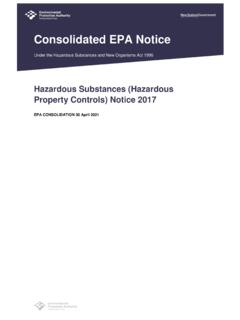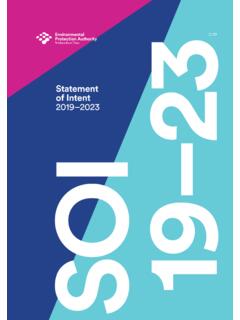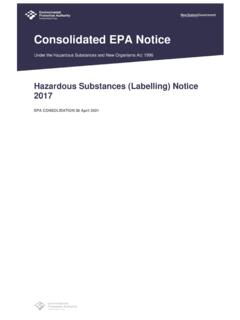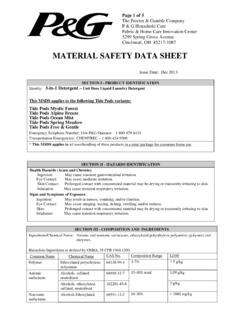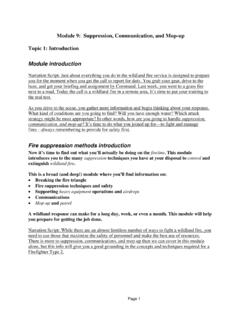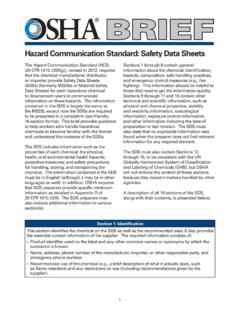Transcription of Guide to classifying hazardous substances in New Zealand
1 22 October 2021 Guide to classifying hazardous substances in New Zealand (Version ) Guide to classifying hazardous substances in New Zealand 2 Contents Part 1: Introduction .. 5 Part 2: Physical hazards .. 7 Explosives .. 7 flammable gases .. 8 Aerosols .. 9 Oxidising gases .. 9 Gases under pressure ..10 flammable liquids ..10 flammable solids ..11 Self-reactive substances and mixtures ..12 Pyrophoric liquids ..13 Pyrophoric solids ..13 Self-Heating substances and mixtures ..13 substances and mixtures which, in contact with water, emit flammable gases ..14 Oxidising liquids ..15 Oxidising solids ..15 Organic peroxides ..17 Corrosive to metals ..18 Desensitised explosives ..19 Part 3: Health hazards .. 20 Acute toxicity ..20 Skin corrosion/irritation ..23 Serious eye damage/eye Guide to classifying hazardous substances in New Zealand 3 Respiratory and/or skin sensitisation ..26 Germ cell mutagenicity.
2 28 Carcinogenicity ..30 Reproductive toxicity ..31 Specific target organ toxicity single exposure ..33 Specific target organ toxicity repeated exposure ..36 Aspiration hazard ..38 Part 4: Environmental hazards .. 40 hazardous to the aquatic environment ..40 hazardous to the terrestrial environment ..43 hazardous to the soil environment ..44 hazardous to terrestrial vertebrates ..45 hazardous to terrestrial invertebrates ..46 Appendix: Hazard classifications .. 47 Physical hazards ..47 Health hazards ..49 Environmental Guide to classifying hazardous substances in New Zealand 4 Document control Version Date issued Owner Description 22 Oct 2021 General Manager, HSNO Initial release of Guide to classifying hazardous substances in New Zealand Reviewers Position Date Action Senior Communications Advisor Sep 2021 Comms review Senior Advisors, hazardous substances Oct 2021 Peer review Principal Scientist, hazardous substances Oct 2021 Review and endorse General Manager, HSNO 22 Oct 2021 Approve Guide to classifying hazardous substances in New Zealand 5 Part 1: Introduction This Guide provides an overview of how to classify hazardous substances using New Zealand s hazard classification system.
3 This system is implemented via the hazardous substances (Hazard Classification) Notice 2020, which implements elements of the seventh revised edition of the Globally Harmonized System of Classification and Labelling of Chemicals (GHS). The notice also sets out a hazard classification framework for substances that are hazardous to the terrestrial environment. The GHS Book1 is the definitive source of classification criteria and detailed information on test methods, mixture rules, expert judgement, and other technical considerations. This Guide to New Zealand s implementation of GHS only covers the most frequently used information when classifying substances . This Guide summarises how to apply classifications to a single substance, and how to use mixture rules for classifying mixtures where formulation test data is not available. Comparisons to the previous alpha-numeric HSNO classifications are made for some classifications. Where a 1:1 correlation exists between a GHS classification and an old HSNO alpha-numeric classification, the correlation table included in Schedule 3 of the hazardous substances (Hazard Classification) Notice2 can be used to assign GHS classifications.
4 This Guide also provides details on the New Zealand -specific considerations in our implementation of GHS: classification categories New Zealand has not adopted optional classification subcategories New Zealand has not adopted New Zealand s additional classifications for substances that are hazardous to the terrestrial environment concentration cut-offs New Zealand has adopted for classification of mixtures. New Zealand has not adopted all elements of GHS 7. The GHS system allows regulators some flexibility regarding what hazard classifications, and what concentration cut-offs are adopted. New Zealand has not adopted the following GHS classifications within its hazard classification system: acute toxicity Category 5 (all exposure routes) skin irritation Category 3 aspiration hazard Category 2 hazardous to the aquatic environment acute Categories 2 and 3 hazardous to the ozone layer. Where the GHS 7 provides optional concentration cut-off values for classification of mixtures, New Zealand has adopted the lower concentration cut-off values.
5 These values are specified in Schedule 2 of the hazardous substances (Hazard Classification) Notice and are also listed in the relevant sections of this Guide . 1 GHS ( ) (2017) | UNECE. 2 hazardous substances (Hazard Classification) Notice: Guide to classifying hazardous substances in New Zealand 6 An additional non-GHS hazard class hazardous to the terrestrial environment has been incorporated into the New Zealand hazard classification system. It is applied only to agrichemicals or active ingredients used in the manufacture of certain agrichemicals. The hazard class hazardous to the terrestrial environment comprises four hazard classifications: hazardous to soil organisms hazardous to terrestrial vertebrates hazardous to terrestrial invertebrates designed for biocidal action. This Guide outlines all of the adopted classifications and concentration cut-offs in detail in the following sections. A full list of the classifications that form New Zealand s classification system is provided in an appendix to this document.
6 An abbreviated form of each classification is also provided that can be used in situations such as inventory lists. Guide to classifying hazardous substances in New Zealand 7 Part 2: Physical hazards3 Explosives There are seven categories of explosives: unstable explosives, and six divisions for substances , mixtures and articles that are not unstable explosives. Explosives are classified in one of the six divisions based on Test Series 2 to 8 in Part I of the UN Recommendations on the Transport of Dangerous Goods (UNRTDG), Manual of Tests and Criteria (Manual of Tests and Criteria). In addition, New Zealand has adopted the explosive compatibility groupings from the UNRTDG Model Regulations which are currently outside of the GHS. The adopted classifications, compatibility groups and types of hazards are shown in table 1. Table 1: Classifications, compatibility groupings and types of hazard for explosives Classification Type of hazard Unstable explosive substances too thermally unstable and/or too sensitive for normal handling, transport and use , , , , , , , , substances and articles that have a mass explosion hazard , , , , , , , , , substances and articles that have a projection hazard but not a mass explosion hazard , , , , , , substances and articles that have a fire hazard and either a minor blast hazard or minor projection hazard, or both, but not a mass explosion hazard.
7 substances and articles that present no significant explosive hazard or that present only a small hazard in the event of ignition or initiation D Very insensitive substances that have a mass explosion hazard but are so insensitive that there is very little probability of initiation or of transition from burning to detonation under normal conditions N Extremely insensitive articles that do not have a mass explosion hazard 3 GHS 7 Part 2, Physical hazards: Guide to classifying hazardous substances in New Zealand 8 flammable gases A flammable gas is a gas having a flammable range with air at 20 C and kPa (Standard Temperature and Pressure, STP). flammable gases are divided into categories 1A, 1B, or 2 based on their flammable properties as shown in table 2. A flammable gas Category 1A may be further categorised as a pyrophoric gas or in one of two divisions of chemically unstable gas. Section of the GHS book lays out the decision flow charts and guidance needed for this class.
8 Table 2: Classifications and criteria for flammable gases Classification Classification criteria Comments flammable gas Category 1A Gases that at STP: are ignitable when in a mixture of 13% or less by volume in air; or have a flammable range with air of at least 12 percentage points regardless of lower flammability limit. Unless data shows the gas meets the criteria for Category 1B flammable gas Category 1A pyrophoric gas flammable gases that ignite spontaneously in air at 54 C or below flammable gas Category 1A chemically unstable gas A flammable gases which are chemically unstable at STP flammable gas Category 1A chemically unstable gas B flammable gases which are chemically unstable at a temperature greater than 20 C and/or a pressure greater than kPa flammable gas Category 1B Gases which meet the flammability criteria for Category 1A, are not pyrophoric and not chemically unstable, and have either: a lower flammability limit of more than 6% by volume in air.
9 Or a fundamental burning velocity of less than 10 cm/s flammable gas Category 2 Other gases which have a flammable range while mixed in air at STP Methyl bromide and ammonia are both Category 2 Guide to classifying hazardous substances in New Zealand 9 Aerosols An aerosol in this context: is a non-refillable receptacle made of metal, glass, or plastics contains a gas compressed, liquefied or dissolved under pressure, with or without other liquid, paste or powder ingredients ; and is fitted with a release device allowing the contents to be ejected as solid or liquid particles in suspension in a gas, as a foam, paste or powder or in a liquid state or in a gaseous state. There are three categories of aerosol based on the flammable properties of the ingredients and their heat of combustion . The classifications and criteria for aerosols are shown in table 3. Aerosols should be considered for Category 1 or 2 if they contain more than 1% of ingredients that are classified as flammable gases, flammable liquids, or flammable solids, or if their heat of combustion is at least 20 kJ/g.
10 Table 3: Classifications and criteria for aerosols Classification Classification criteria Aerosol Category 1 Aerosol with >1% flammable ingredients or a heat of combustion of at least 20 kJ/g are classified as Category 1, unless test data shows they meet the criteria of Categories 2 or 3. The criteria for differentiation between Categories 1 and 2 depend on the results of the foam test for foam aerosols, or ignition test distance and the enclosed space test for spray aerosols. Aerosol Category 2 Aerosol Category 3 Aerosols that do not meet the criteria for Category 1 or Category 2. Oxidising gases The oxidising power of an oxidising gas mixture can be determined by tests or calculation according to ISO 10156:2010 Gases and gas mixtures Determination of fire potential and oxidizing ability for the selection of cylinder valve outlets. The classification and criteria for oxidising gases are shown in table 4. Table 4: Classification and criteria for oxidising gases Classification Classification criteria Oxidising gas Category 1 Any gas that contributes to the combustion of other material more than air does (generally by providing oxygen).


